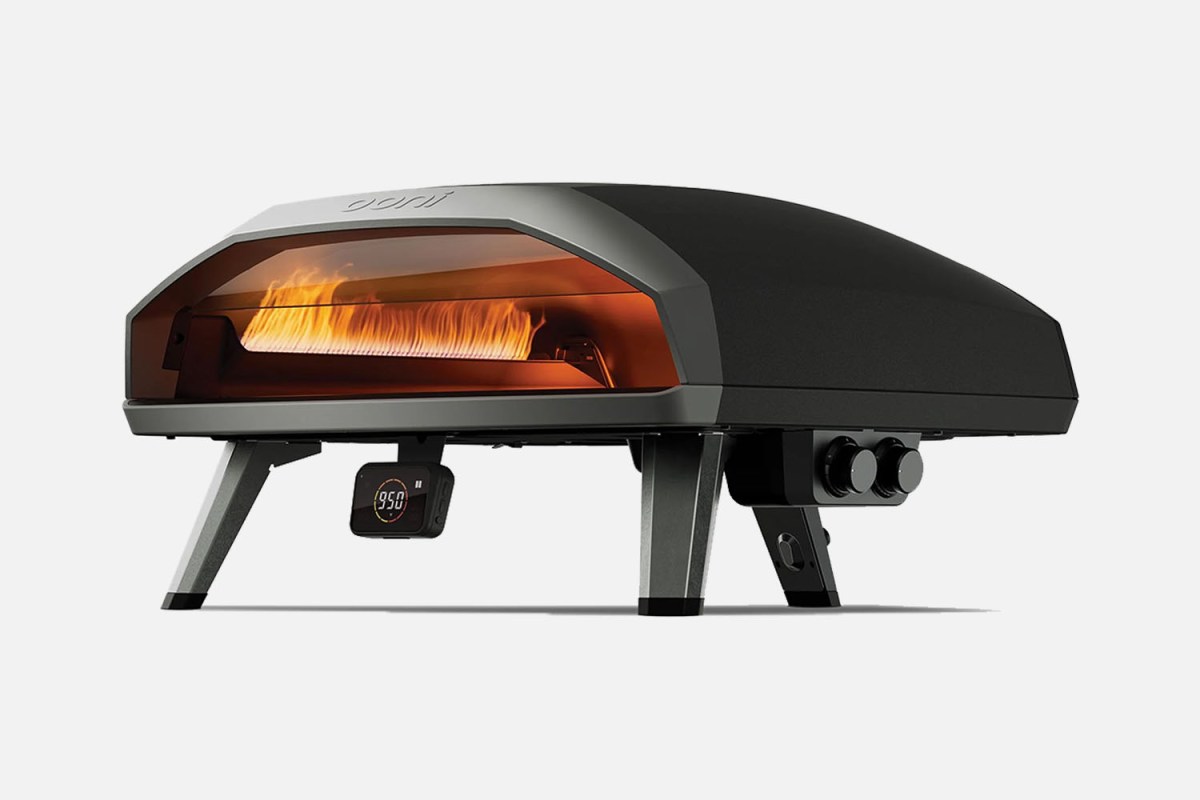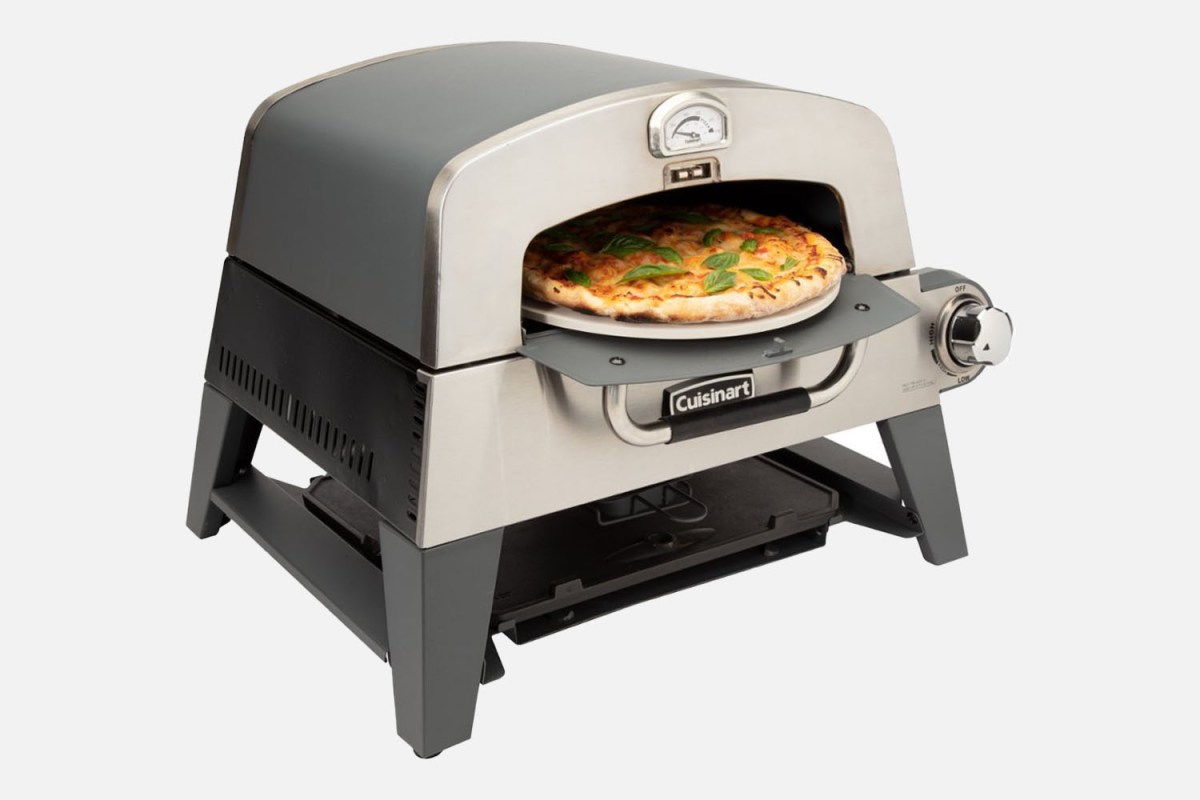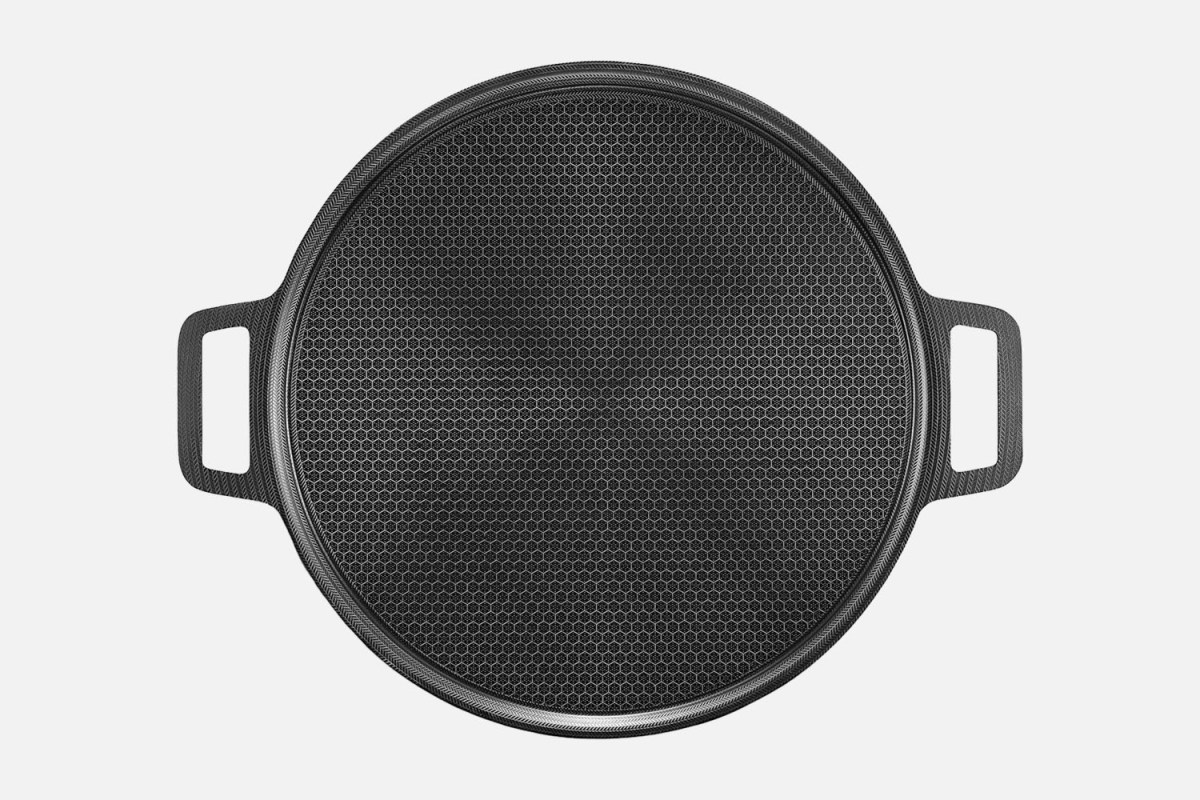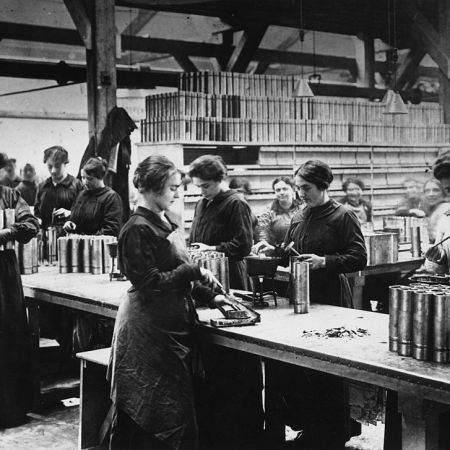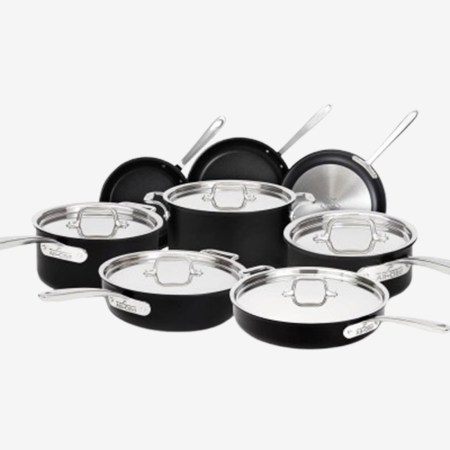Nota bene: All products in this article are independently selected and vetted by InsideHook editors. If you buy something, we may earn an affiliate commission.
There’s never been a better time to make pizza at home than right now. A revolution in consumer ovens has brought cooking high-heat, Neapolitan-style pies to the masses. A few years ago you might have had to build your own wood-fired oven to make these at home; now, anyone with a few hundred bucks can get a portable oven delivered right to their front door. Other tools, from Detroit-style pans to heavy metal baking steels, have elevated the game in ordinary ovens too. The time is nigh to skip the frozen pizza aisle: with a little prep and practice, you can make far better pies right in your own kitchen.
We’ve taken a look at three recent additions to the home pizza landscape: a game-changing oven from Ooni, a 3-in-1 oven, grill, and griddle from Cuisinart, and a new non-stick steel from HexClad. Each provides a different method of crisping up your at-home pies; all are worth your time. The only question left to explore: which at-home pizza oven set-up is right for you?
Which At-Home Pizza Oven Is Right For You?
- The Ultimate At-Home Pizza Oven: Ooni Koda 2 Max, $999
- The Affordable, Multi-Use Alternative: Cuisinart 3-in-1 Pizza Oven Plus,
$200$170 - The Pizza Oven-Adverse Hack: HexClad Hybrid Pizza Steel, $150
Ooni Koda 2 Max: The Ultimate At-Home Pizza Oven
Scottish company Ooni has long been a market leader in high-end home pizza ovens. Their Koda 16 model made significant strides over previous models, offering a larger cooking area and flames on two sides of the oven instead of just one. They’ve taken another gigantic step forward with their newest release, the Koda 2 Max, which expands the cooking deck to a whopping 24 inches.
This thing is a beast. When I assembled the review model, I just had to laugh because it was such an absurdly large oven to have sitting on the floor of my one-bedroom apartment. I could neither cook with it there, where I lack the outdoor space, nor fit it into my sedan to take it somewhere else. Unless your name is “The Mountain,” carrying this anywhere is realistically a two-person job. Testing the oven required loading it into the back of my girlfriend’s SUV and hauling it around Portland to a series of backyard pizza gatherings.
What the Koda 2 Max lacks in portability it more than makes up for with performance. It’s a dream to cook with. It offers everything you’d expect from an Ooni oven, with a sleek design, highly conductive cordierite deck, and temperatures that reach up to 950 F. If you’ve made pizzas in other Ooni ovens, using this one will feel familiar. But it’s a step up from previous models for reasons beyond mere size.

A challenge with cooking pizzas in any consumer-sized oven is getting an even char on the rim of the crust (called the cornicione if you want to sound fancy). The edges that are closest to the flames are always going to char faster than edges facing away. Many smaller consumer models have flames in the rear, making it hard to see how quickly the crust is browning and all too easy to burn it to a crisp.
The Koda 2 Max solves these problems. The two lines of flame come from the sides only, making it much easier to keep an eye on the crust and allowing for a more even cooking process. The roomier oven also allows for more distance from the direct flames. As a result, one can be a little more relaxed while cooking. Giving a pie a casual quarter-turn about midway through is usually all it takes to get a cornicione that’a evenly-cooked, charred in spots, pillowy, and delicious.
The new Ooni also allows you to control the two lines of flames with separate dials for even more precise control. A digital display shows the average temperature across the whole oven or separately for each half so that you can make adjustments on the fly, turning flames up or down to ensure even cooking. Conceivably you could create a temperature gradient to cook two different-style pizzas at the same time or even entirely different dishes. The digital display also connects to your phone via Bluetooth, and the oven comes with additional temperature probes you can use for roasting meat, though we didn’t test these options.

We were more entranced by this oven’s capacity to handle really large pies. I’ve cooked a ton of pizzas in a variety of home ovens over the years, all of which constrain the size to 12-14 inches in diameter. The Koda 2 Max easily takes a 20-inch pie (though I had to visit a restaurant supply store to buy a peel big enough to launch it). Bigger isn’t inherently better, but it turns out there’s something really satisfying about stretching out a giant dough, slinging it into a super hot oven, and presenting your friends with a massive pizza. It’s as close as you can get to being a professional pizzaiolo without quitting your day job, and it’s just really, really fun.
The few details I could critique on this oven are so nitpicky as to be hardly worth mentioning. It can be a bit finicky to light sometimes, and the dials don’t have the same tactile feedback as the Koda 16. But these are very minor complaints. The only real downsides to the Koda 2 Max are its cost and the amount of space it takes up. You can buy cheaper ovens and you can buy ovens that are easier to move around, and for many consumers those are going to be more practical options. But if you don’t mind dropping a grand on a pizza oven and have the space for it, you’re going to love cooking with this one.
Cuisinart 3-in-1 Pizza Oven Plus: An Affordable, Multi-Use Alternative
For a smaller and lower cost entrant into the consumer oven space, Cuisinart offers a “3-1” oven that functions as a pizza oven, grill, and griddle all in one. The appliance compactly holds all three surfaces, which are easily swapped in and out. Flipping the grill surface reveals built-in pegs that hold the stone securely in place. It’s a clever design, but how does it cook?
The answer to that question is a bit mixed. The built-in temperature gauge goes up to 700 degrees, with the 500-plus range demarcated as the “pizza zone.” (I love entering the pizza zone.) This is not quite Neapolitan range, but it should be plenty hot to cook a good pizza. There is a catch, however. Unlike ovens designed more specifically for pizza, which have flames within the oven chamber, this one is heated entirely from below. The stone itself gets very hot, but there is much less heat radiating from above.

What this means in practice is that pizzas get well-cooked below but with the rim and toppings underdone. Our pies consistently came out with nicely spotted char on the bottom but almost no color at all on the cornicione, which ends up soft and pliable but with none of the crustiness or char you find on a good Neapolitan or New York-style pie.
Frustrated by these results, one of our testers suggested making a calzone instead of pizza. Flipping a calzone midway through the bake puts the crust in contact with the hot stone on both sides, compensating for the lack of heat from above. This turned out great, light and airy on the inside and nicely charred on the outside.
Similarly, we got very good results testing out flatbreads on the griddle surface. High heat and flipping midway through made very tasty breads with lots of char and bubble. Brushed with olive oil and seasonings like za-atar, they’d make a fantastic addition to a night of grilling out.

And how about that grill function? This is where the Cuisinart excels the most. Classic steak and carne asada came off juicy, tender, and well-charred. Skewers were a flavorful delight. Vegetables blackened nicely. For a small-sized grill, we were all quite happy with the results. I’ll probably never cook another pizza in this oven, but I’ll definitely use it to grill.
The list price is $199 and it can be snagged for significantly less on sale. As one might expect for the price, there are a few parts that feel cheap. The metal is thin and the oven door malfunctioned at one point, requiring us to make adjustments with a screwdriver while it was a scorching 600 degrees, which is not high fun.
With that in mind, approaching this as primarily a pizza oven strikes me as a mistake. You’ll get better results in your standard home oven or by spending a bit more for a small dedicated pizza oven. But if you’re in the market for a compact and convenient propane grill that you can also use for flatbreads and the occasional calzone, this is a solid option.
HexClad Hybrid Pizza Steel: A Nifty Hack For the Pizza Oven-Adverse
You don’t need a specialty oven to make excellent pizza at home. You can get great results in your regular home oven too. One of the best tools for elevating your game is nothing more than a big old slab of metal known as a baking steel.
As explained in our earlier guide to home pizza-making, a baking steel is a recent invention stemming from the realization that steel conducts heat better than a pizza stone. When you pre-heat a slab of steel in your oven and slide a pie onto it, that heat gets rapidly transferred to the dough, giving you a leopard-spotted crust on the bottom and airy, toasty crust at the edge.
Up to now, baking steels have been pretty low-tech. Enter the new Hybrid Pizza Steel from Hexclad. Their version is made with an aluminum core and a non-stick surface that Hexclad says is oven-safe up to 900 degrees. Most curiously, Hexclad claims that their steel works without the need to pre-heat it, thanks to the faster heating of the aluminum core.
This claim elicited immediate skepticism from experienced pizza cooks. That’s just not the way physics works. If you want that immediate blast of heat that a baking steel provides, it needs to start out hot. But still, I was curious to see how the Hexclad steel would work without pre-heating, so I made several pies by forming them directly on the room-temperature steel and then placing it into my pre-heated home oven.

How did it work? Pretty well, actually. It didn’t replicate the results of cooking on a hot steel, but it did make a nice pie. The bottom surface of the crust came out more of a light brown rather than the black leopard-spotting you get with a very hot steel. The crust is also a little less airy thanks to its slower heating, and the bake took a few minutes longer than my usual recipe. These weren’t in the top tier of pizzas I’ve ever made, but they were respectable.
Thankfully, one doesn’t have to use the HexClad steel without pre-heating. You can put it in your oven to soak up heat and slide a pizza onto it, just as one would with a normal steel. Cooking with it this way yields results more in line with my expectations, with darker char and an airier crust.
The big question is how this compares to a simpler baking steel. At $149, the HexClad is one of the more expensive options; the original Baking Steel is just $119, and there are other cheaper options online (though many of these are thin and therefore hold less heat). The HexClad is non-stick and weighs just 4.5 pounds compared to the Baking Steel’s 15. That presents a tradeoff in heat capacity, but it does make it easier to move around.
I predict that hardcore pizza cooks will prefer a more conventional steel, with its larger mass and brute force approach to transferring heat to dough. But I can also see the appeal of the HexClad version. Slinging uncooked pies onto a hot steel can be intimidating for beginners, and when you mess up you can ruin your whole dinner. For a pizza newbie, the HexCad offers a more gradual learning curve: you can start by forming pies on the unheated pan and work your way up to more advanced techniques like launching a pie from a wooden peel.

It’s kind of like learning how to ride a motorcycle. Do you want to jump right onto a Harley or ease into it with a single-speed scooter? There are advantages to both. The HexClad is like the scooter: it’s easier to learn on, harder to mess up, and will get you mostly where you want to go. But after a while, you might find yourself wanting to upgrade to a more powerful ride.
Owning both, the conventional steel is still what I’ll reach for to make my best pizzas at home. But I do find myself glad to have the HexClad around. With pre-heating it performs pretty well for pizza, and thanks to its lighter weight and non-stick surface I’ve found myself picking it up for tasks like roasting vegetables, which I would never do with my baking steel.
Not everyone wants to lug a 15-pound slab of steel around their kitchen or jump right into launching pies from a peel. If you want to get the best results possible in your home oven, those steps are worth taking. But if you want to take a more gradual approach to making better pizza, the new Hybrid Steel from HexClad is a viable way to start.
We've put in the work researching, reviewing and rounding up all the shirts, jackets, shoes and accessories you'll need this season, whether it's for yourself or for gifting purposes. Sign up here for weekly style inspo direct to your inbox.

